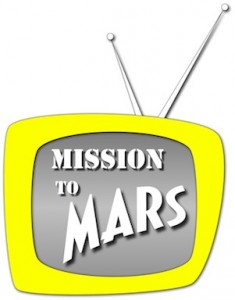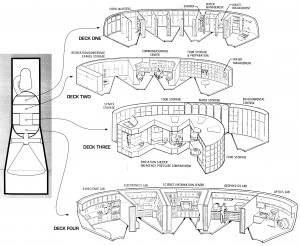 In our previous installment, Colonel Elizabeth Braden meets the crew of the Mars expedition for the first time as their new commanding officer when the crew is introduced to the media at a press conference. Although Major Marshall Endicott, the mission’s second-in-command, is uncomfortable with the choice of Braden over himself as the mission’s leader, the two of them make an uneasy truce. How long it can last, though, remains to be seen . . .
In our previous installment, Colonel Elizabeth Braden meets the crew of the Mars expedition for the first time as their new commanding officer when the crew is introduced to the media at a press conference. Although Major Marshall Endicott, the mission’s second-in-command, is uncomfortable with the choice of Braden over himself as the mission’s leader, the two of them make an uneasy truce. How long it can last, though, remains to be seen . . .
* * *
The Big Gemini spacecraft carrying the crew of the Percival Lowell shed its booster stage upon reaching an orbit that would allow it to intercept Orbital Station Peary, where the Lowell was being fitted out for its pioneering mission to Mars. Another routine departure from Kennedy Space Center, with an ultimate destination that was anything but.
The ferry version of the ubiquitous Gemini spacecraft — nicknamed the “Gusmobile” after astronaut and current NASA Deputy Director Gus Grissom, who had played a major role in its design — the Big Gemini featured an enlarged cabin with room for up to six passengers in addition to the two pilots up front. On this flight, Braden and Endicott were in the pilots’ seats, with Collinson, Boggins, and Serrona in the rear compartment along with several large cargo canisters strapped to the bulkheads around them.
As smoothly as if they had been a team for years already, Braden and Endicott guided the Big Gemini to its rendezvous. Both of them had dozens of Gemini flights in their logbooks already, and knew the vehicle as well as their own cars. Even so, as the pudgy, donut-shaped Peary suddenly appeared from the darkness as its orbit carried it across the terminator into daylight — followed a moment later by the unmistakable javelin shape of the Lowell — both of them paused to take in the spectacle through the spacecraft’s oval windows.
“We have the Lowell in sight,” Braden called to the rest of the crew. “It’s a lovely sight.” She turned her helmeted head. “Major, would you do the honors?”
“Gladly, Colonel,” Endicott responded buoyantly. Tweaking his control joystick, he turned the Big Gemini sideways so the passengers could peer through one of the small portholes in the rear compartment. The three astronauts took turns peering and snapping photos, exclaiming their impressions of their Mars chariot as it grew larger in the window [see this image].
Most of the spacecraft was fuel and engines. The first stage, consisting of three white NERVA rockets strapped together in parallel, served as the “base” of the vehicle. Above this stage, two more NERVA engines sat perched end-to-end, connected by dense webs of silver struts. And at the very top end, much smaller than the engines by comparison, perched the Lowell; a slender white cylinder with a widening conical skirt at the very front [see this image]. This would be their home for the next four hundred days.
“Okay, show’s over.” Endicott nudged the capsule’s nose back toward their objective.
“Aww,” joked Boggins.
“Don’t make me pull over, Sergeant,” Endicott shot back. The communications channel filled with laughter as the Big Gemini approached the Lowell for docking.
* * *
With the skill of a veteran, Endicott backed the Big Gemini toward one of the Lowell’s two logistic vehicle docking ports, located halfway up the conical nose of the skirt housing the Mars lander. Once the docking hatch at the rear of the capsule’s passenger compartment was securely connected to the port, Collinson opened the hatch and slid feet-first down the connecting tunnel that would connect to the main tunnel running the length of the Lowell. One by one, the other astronauts floated their way down the tunnels, their bulky silver spacesuits making the trip awkward. But at least they could remove their helmets at last, as the Lowell was pressurized and powered up, waiting for their arrival.Arriving at the hatch at the top of Deck One, Collinson opened it and called down jovially, “anyone home?”
“Hello!” responded a member of the launch crew, who along with a team of others were completing the fitting-out procedures. “Welcome aboard. You fellows ready to take our buggy for a fun little field trip?”
“You’d better believe it!” said Boggins as he glided into the crew quarters that ringed the deck, a duffel bag slung over his shoulder. Each member of the crew had a wedge-shaped private compartment separated by a privacy curtain, which opened up into a circular common area where the crew now congregated. “Which one’s mine?” Without waiting for an answer, he tossed his duffel into the nearest compartment, only to have it rebound off the cabin wall and glide back into his hands. “Oops,” he said, blushing as the others laughed. He tried again, this time nudging it gently into his chosen space.
Careful to avoid disturbing the launch crews who were intent on their work, the five Lowell crew proceeded through the hatch in the center of the circular floor to the next deck, which was divided into three open compartments: the Lowell’s command center, packed with control panels and display screens; the food and water compartment, ringed with shelves and drawers; and the conference and recreation room, which was designed to feel spacious despite its actual size.
Most of the launch crew members were congregated on this floor, so the astronauts continued down through the third deck, ringed with storage tanks for air and water and dominated by a thick, puck-shaped radiation shelter to protect them against solar storms or an unlikely accident with one of the NERVA boosters, and into the laboratory deck at the base of the crew compartment.
If the command center on Deck 2 was the nerve center of the Lowell, the labs on Deck 4 were the entire reason for the trip. Braden watched with pleasure as Collinson’s and Serrona’s eyes lit up at the bright, new, shiny science equipment in the five laboratories ringing the deck.
“Welcome to the largest, most sophisticated science facility ever put into space,” she said with the tone of a proud mother. As the Mars Expedition’s operations director prior to her sudden promotion by General Carstairs, she had been responsible for overseeing the design of the Lowell’s laboratory facilities. She had insisted on sparing no expense, and it showed. “It rivals some of the best facilities on Earth, too. And it’s all yours, gentlemen.”
The five astronauts drifted from console to console, admiring the equipment that they would soon be using to unveil the mysteries of interplanetary space and, ultimately, the Red Planet itself. Suddenly, an urgent cry came from the deck above. “Colonel Braden! Come quick!”
The five of them looked up at the source of the sound, and followed Braden as she pushed off the floor and glided speedily up through the hatch. “Up here! In the crew quarters!”
“Make a hole!” Braden called ahead as she shot up through the decks, betraying her Navy-brat roots (her father was a retired nuclear submariner). The others followed, Boggins bringing up the rear and issuing a stream of curses as his knees and elbows kept connecting with the hatchways as he passed through them.
“What is it?” said Braden to the two gray-coveralled technicians who floated in the center of the deck.
“There,” one of them said, pointing to one of the compartments. Boggins’ duffel bag was bouncing crazily around the room, ricocheting off the walls and spinning wildly.
“What’s going on?” Boggins called as he stumbled through the floor hatch into the room. “What’s the problem?” When he saw his duffel careening around his compartment, he went pale. “Oh, no,” he said with a gasp.
“What is it?” Endicott barked. “What’s in there?”
Before Boggins could answer, a feeble, high-pitched sound emanated from deep within the bag. A moment later, it was followed by another, louder cry, the unmistakable warbling wail of . . .
A dark gray furry head poked out from one end of the duffel, its bewhiskered mouth uttering a piteous wail, its eyes open wide in confusion, its long ears cocked back in fear.
“A cat?” asked Braden in astonishment.
“a cat!” confirmed Endicott. All eyes turned to Boggins, who was drifting backwards in disbelief.
“I . . . ” Boggins stammered. “He’s a stray. I found him last week. He wandered into my house. And he was so cute, I . . . ” under the withering glare of Braden and Endicott, and the astonished gaze of everyone else, Boggins paused to regroup. “I was going to leave him with my girlfriend while I was away, but she’s allergic.” He shrugged. “A member of the Canaveral ground crew raises cats. I brought him along to give to her. And I . . . ”
“You . . . ?” encouraged Braden impatiently.
“. . . forgot,” he finished sheepishly.
The cat yowled again, and all eyes turned back to the cat as it finished struggling its way out of the bag and cartwheeled its legs wildly in the air, unaccustomed as it was to the lack of gravity.
After a moment, Collinson broke the silence. “What are we going to do with the cat?”
Braden and Endicott looked at each other.
* * *
What will become of the Lowell’s feline stowaway? Whatever the crew decides, they’ll have to decide soon, because the launch countdown is about to start! Find out in the next installment of Mission to Mars!



This story is to tight! Trying to picture a floating Gunny!
Pingback: M2M Part 4 -- "The Next Giant Leap" | Channel 37